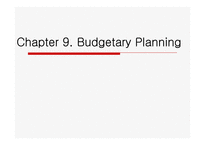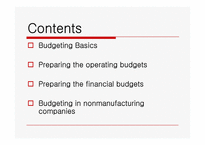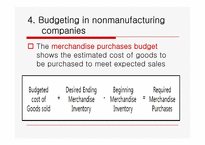2.Preparing the operating budgets
3.Preparing the financial budgets
4.Budgeting in nonmanufacturing companies
What is a budget?
Primary benefits of budgeting
-Requires management to plan ahead and to formalize goals
-Provides definite objectives
-Creates an early warning system
-Facilitates the coordination of activities
-Results in greater management awareness
-Motivates personnel
The master budget is a set of interrelated budgets that constitutes a plan of action for a specified time period.
↓
Operating budget
Financial budget
Sales budget
Production budget
Direct materials budget
Direct labor budget
Manufacturing overhead budget
Selling and administrative expense budget
Capital expenditure budget
Cash budget
Budgeted balance sheet
The cash budget shows anticipated cash flows
↓
Cash receipts section
Cash disbursements section
Financing section
The budgeted balance sheet is a projection of financial position at the end of the budget period
Budgeted balance sheet
for the preceding year
+
Budgets for the
current year
=Budgeted balance sheet
for the current year
Budgets are also used by merchandisers, service enterprises, and not-profit organizations
Merchandiser
Difference between master budget of a merchandiser and a manufacturer are
Merchandiser uses a merchandise purchases budget instead of a production budget
Merchandiser does not use the manufacturing budgets (direct materials, direct labor, and manufacturing overhead)
The merchandise purchases budget shows the estimated cost of goods to be purchased to meet expected sales

- 오늘 본 자료가 없습니다.
- 조지프 슘페터의 자본주의 사회주의 민주주의를 읽고 나서
- 2024학년도 우유급식 설문조사 안내 및 설문조사지
- 고전서평_체사레 베카리아의 범죄와 형벌을 읽고 나서
- 자소서:홍보마케팅자기소개서 7년경력 광고직합격자소서 면접 상품기획사무원 자기소개서 마케팅직자기소개서 광고직자기소개서 홍보직자기소개서 홍보마케팅자기소개서 홍보마케팅 지원동기 자기소개서
- 자기소개서:텔레마케터합격자소서 텔레마케팅 노하우 자소서 보험텔레마케터 자기소개서 학원텔레마케터자기소개서 유학텔레마케터 자기소개서 학습지텔레마케터자소서 텔레마케팅자기소개서 텔레마케터 지원동기 자소서
해당 정보 및 게시물의 저작권과 기타 법적 책임은 자료 등록자에게 있습니다. 위 정보 및 게시물 내용의 불법적 이용,무단 전재·배포는 금지되어 있습니다. 저작권침해, 명예훼손 등 분쟁요소 발견 시 고객센터에 신고해 주시기 바랍니다.
















 분야
분야

